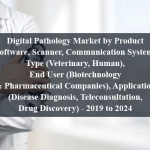OVERVIEW
Research by Global Market Studies has reported a CAGR of 14.98% for the Connected Healthcare Market, expecting to expand to USD 115.51 billion by 2028.
The connected healthcare market utilizes digital technologies and communication networks for seamless sharing, analysis, and exchange of healthcare-related information among stakeholders, integrating medical devices, wearable sensors, and telemedicine platforms.
Remote Patient Monitoring (RPM) and telemedicine enable remote monitoring of patient’s health status, reducing hospital readmissions and enhancing engagement. Wearable devices, EHRs, and VR/AR technologies improve patient care coordination, medication management, and patient education.
Market Dynamics
Drivers:
The evolution of technology, such as IoT, AI, and cloud computing, has led to the development of sophisticated connected healthcare devices and applications. The global aging population has increased chronic disease prevalence and demand for healthcare services, making connected healthcare solutions essential for efficient and cost-effective care delivery. Cost containment can be achieved through early detection, preventive care, and optimizing resource utilization.
Personalized healthcare solutions cater to individual needs, and connected healthcare technologies can bridge the gap between patients and healthcare providers, especially in remote or underserved areas. Governments worldwide are supporting connected healthcare initiatives to improve overall healthcare outcomes.
Opportunities:
Connected healthcare offers various benefits, including remote patient monitoring (RPM), telemedicine, personalized healthcare, health data integration, improved efficiency and accessibility, and data-driven insights. RPM devices and applications collect vital signs, chronic conditions, and other health metrics, enabling healthcare providers to intervene early in case of issues. Telemedicine platforms enable timely diagnosis and treatment, especially for individuals in remote or underserved areas. Personalized healthcare plans and interventions based on individual health data lead to better health outcomes and patient satisfaction. Health data integration consolidates data from various sources, improving care coordination and holistic patient care.
Improved efficiency and accessibility result from streamlined workflows, reduced administrative burdens, and enhanced communication among healthcare teams. Data-driven insights can be derived from the vast amount of data generated by connected healthcare devices and applications, enabling predictive analytics, disease monitoring, and personalized treatment recommendations.
Restraints:
Data privacy and security concerns arise from the interconnected nature of connected healthcare systems, necessitating robust security measures to protect patient data. Interoperability challenges arise from the use of different data formats and standards, hindering widespread adoption. Regulatory and compliance issues are complex, requiring complex and time-consuming navigating for healthcare providers and technology developers. Cost and infrastructure requirements, such as reliable internet connectivity and infrastructure, pose challenges, especially in remote or resource-constrained areas. The digital divide can limit the adoption of connected healthcare solutions, especially among elderly and underserved populations. Additionally, physicians resisting adoption and training can slow down the implementation process.
Regional Information:
North America: The US has led linked healthcare development and implementation. The region’s healthcare system, digital health investments, and technical readiness are strong. Telemedicine, remote patient monitoring, and health wearables are popular here. Value-based care and population health management have encouraged connected healthcare solutions.
Europe: Europe has been adopting linked healthcare technology to improve patient care, access, and cost. European countries have introduced electronic health record systems and telemedicine programs. Data privacy and interoperability are regional problems.
Asia-Pacific: Technological improvements, rising healthcare infrastructure, and the need to solve healthcare concerns in populous countries have driven connected healthcare growth in Asia-Pacific. China, Japan, and South Korea are pioneers in telemedicine, mHealth, and AI-driven healthcare.
Recent Developments:
• August 2022 – Medtronic plc declared entering a strategic partnership with BioIntelliSense, a continuous health monitoring and clinical intelligence company, for the US hospitals only and 30-day post-acute hospital-to-home distribution rights of the BioButton multi-parameter wearable for straight, connected monitoring. The partnership allowed the Medtronic Patient Monitoring business to access a medical-grade device primarily offering continuous vital sign measurements of general care patients in-hospital and post-discharge.
• March 2022 – Microsoft Corp. declared updates to Microsoft Cloud for Healthcare and developments in cloud technologies for life sciences and healthcare with the general availability of its Azure Health Data Services. With the recent acquisition of Nuance Communications, Microsoft accelerates an organization’s ability to assist others by leveraging trusted AI to address the most significant challenges transforming the future of healthcare.
• January 2022 – Abbott announced the development of a new consumer bio wearable, Lingo, primarily built to detect critical body signals, like ketones, glucose, and lactate, helping people better understand their general health and take the required action.
Key Players:
Boston Scientific, Airstrip Technology, IBM, Apple, Microsoft, Oracle, Honeywell, GE Healthcare, Medtronic, Koninklijke Philips N.V.
Frequently Asked Questions
1) What is the projected market value of the Connected Healthcare Market?
– The Connected Healthcare Market is expected to reach USD 115.51 billion by 2028.
2) What is the estimated CAGR of the Connected Healthcare Market over the 2023 to 2028 forecast period?
– The Connected Healthcare Market is expected to grow at a CAGR of approximately 14.98% from 2023 to 2028.
3) Who are the key players in the Connected Healthcare Market?
– Boston Scientific, Airstrip Technology, IBM, Apple, Microsoft, Oracle, Honeywell, GE Healthcare, Medtronic, Koninklijke Philips N.V.
4) What are the drivers for the Connected Healthcare Market?
– Technology advancements like IoT, AI, and cloud computing enable connected healthcare devices, addressing global aging, chronic diseases, and cost containment.
5) What are the restraints and challenges in the Connected Healthcare Market?
– Data privacy, security, interoperability, regulatory, compliance, cost, infrastructure, digital divide, and physician adoption are challenges in connected healthcare systems, hindering widespread adoption.
6) What are the key applications and offerings of the Connected Healthcare Market?
– Remote Patient Monitoring (RPM) and telemedicine enable remote monitoring of patient’s health status, reducing hospital readmissions and enhancing engagement. Wearable devices, EHRs, and VR/AR technologies improve patient care coordination, medication management, and patient education.
7) Which region is expected to drive the market for the forecast period?
– North America has the highest value share in the global market and is expected to dominate shares in the forecast period.
Why Choose Us?
Insights into Market Trends: Global Market Studies reports provide valuable insights into market trends, including market size, segmentation, growth drivers, and market dynamics. This information helps clients make strategic decisions, such as product development, market positioning, and marketing strategies.
Competitor Analysis: Our reports provide detailed information about competitors, including their market share, product offerings, pricing, and competitive strategies. This data can be used to inform competitive strategies and to identify opportunities for growth and expansion.
Industry Forecasts: Our reports provide industry forecasts, which will inform your business strategies, such as investment decisions, production planning, and workforce planning. These forecasts can help you to prepare for future trends and to take advantage of growth opportunities.
Access to Industry Experts: Our solutions include contributions from industry experts, including analysts, consultants, and subject matter experts. This access to expert insights can be valuable for you to understand the market.
Time and Cost Savings: Our team at Global Market Studies can save you time and reduce the cost of conducting market research by providing comprehensive and up-to-date information in a single report, avoiding the need for additional market research efforts.












